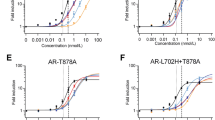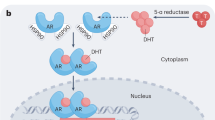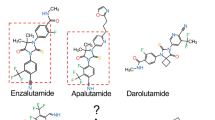Abstract
The non-steroidal antiandrogens flutamide (Eulexin®), nilutamide (Anandron®) and bicalutamide (Casodex®) are widely used in the treatment of advanced prostate cancer, particularly in combination with castration. The naturally occurring ligand 5α-DHT has higher binding affinity at the androgen receptor than the non-steroidal antiandrogens. Bicalutamide has an affinity two to four times higher than 2-hydroxyflutamide, the active metabolite of flutamide, and around two times higher than nilutamide for wild-type rat and human prostate androgen receptors. Animal studies have indicated that bicalutamide also exhibits greater potency in reducing seminal vesicle and ventral prostate weights and inhibiting prostate tumour growth than flutamide. Although preclinical data can give an indication of the likely clinical activity, clinical studies are required to determine effective, well-tolerated dosing regimens. As components of combined androgen blockade (CAB), controlled studies have shown survival benefits of flutamide plus a luteinising hormone-releasing hormone analogue (LHRH-A) over LHRH-A alone, and for nilutamide plus orchiectomy over orchiectomy alone. Other studies have failed to show such survival benefits, including those comparing flutamide plus orchiectomy with orchiectomy alone, and nilutamide plus LHRH-A with LHRH-A alone. In a direct comparative study, bicalutamide (50 mg, once daily) was compared with flutamide (250 mg, three times daily), each in combination with an LHRH-A. Both therapies were well tolerated, although more patients could not tolerate flutamide therapy: 25 flutamide plus LHRH-A and 2 bicalutamide plus LHRH-A patients withdrew from therapy due to diarrhoea. There were no statistically significant differences for time to progression or survival between the two antiandrogens. This clinical trial of bicalutamide confirms the prediction from preclinical studies that a 50 mg dose of bicalutamide would be appropriate for use in patients with advanced prostate cancer, and demonstrates that this bicalutamide dose is clinically effective when administered as part of CAB.
This is a preview of subscription content, access via your institution
Access options
Subscribe to this journal
Receive 4 print issues and online access
$259.00 per year
only $64.75 per issue
Buy this article
- Purchase on Springer Link
- Instant access to full article PDF
Prices may be subject to local taxes which are calculated during checkout
Similar content being viewed by others
Author information
Authors and Affiliations
Rights and permissions
About this article
Cite this article
Kolvenbag, G., Furr, B. & Blackledge, G. Receptor affinity and potency of non-steroidal antiandrogens: translation of preclinical findings into clinical activity. Prostate Cancer Prostatic Dis 1, 307–314 (1998). https://doi.org/10.1038/sj.pcan.4500262
Received:
Revised:
Accepted:
Published:
Issue Date:
DOI: https://doi.org/10.1038/sj.pcan.4500262
Keywords
This article is cited by
-
Determining direct binders of the Androgen Receptor using a high-throughput Cellular Thermal Shift Assay
Scientific Reports (2018)
-
Targeting the androgen receptor pathway in castration-resistant prostate cancer: progresses and prospects
Oncogene (2015)
-
Enzalutamide, a Second Generation Androgen Receptor Antagonist: Development and Clinical Applications in Prostate Cancer
Current Oncology Reports (2013)
-
Definitive radiotherapy with adjuvant long-term antiandrogen treatment for locally advanced prostate cancer: health-related quality of life and hormonal changes
Prostate Cancer and Prostatic Diseases (2009)
-
Interactions of androgens, green tea catechins and the antiandrogen flutamide with the external glucose‐binding site of the human erythrocyte glucose transporter GLUT1
British Journal of Pharmacology (2003)



